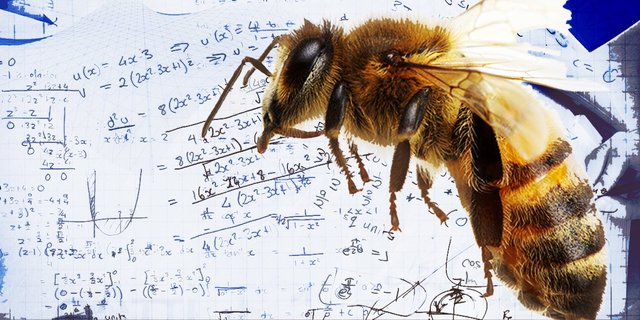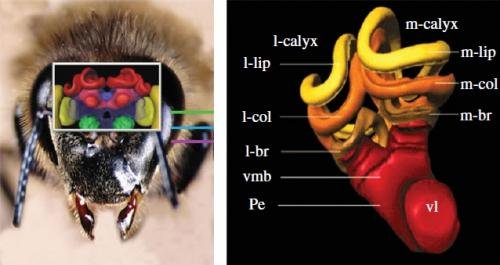HONEY BEES: BAD ASS MATHEMATICIANS

Image Credit1: alekss / 123RF Stock Photo
Image Credit2: Wikimedia Commons
Honey bees are surprisingly great at maths, they know something about nothing. Honey bees understands the hard mathematical concept of nothing that took humans millennia to grasp.
The discovering of nothing is considered one of the greatest cultural achievments of humankind bringing on a major break through in science and mathematics. This actually took along stretch of human history for zero to be recognized and appreciated.
0(zero) is both a number and the numerical digit used to represent that number in numerals. The number 0,fulfils a central role in mathematics as the additive identity of the integers, real numbers and many other algebraic structure. As a digit, 0 is used as a placeholder in place value systems. Names for the number ‘0’ in English includes Zero, Nought (UK), naught(US).
Zero is an extremely complex concept to comprehend. Consignment of things, whether they are communities of people, bundles of fruit, or blocks of wood for construction are indispensable to our livelihood. But as far as the brain is concerned, nothing is far more different than something.

(Left) A 3D reconstruction of a honeybee brain. (Right) A 3D construction of a honeybee mushroom body.
Source: phys.org
Credit: Avarguès-Weber and Giurfa.
©2013 The Royal Society
Its been tough bringing to the table this concept, but our ability to grasp zero as a unique and distinct numerical value is an acute part of modern mathematics, engineering, and technology. In current years, we’ve learnt that other animals have also developed an understanding of nothingness. Several species like the non human primates, the Rhesus monkey and the African grey parrot, can all and easily identify ‘none’ as something, and in accordance to research, Honey Bees belong to that maths club as well. LOL.
THE RHESUS MONKEY ZERO CONCEPT OF NOTHINGNESS
The university of Tiibingen neuroscience researchers headed by professor Andreas Neider now have some answers as to how and where brain cells depict a zero amount as apart of the number line.
Image Source: Wikimedia Commons
The reseachers trained two Rhesus Monkeys to asses the number of dots on a computer screen from zero to four in the test, the Monkeys judged ‘nodots’ as the number closet to one, thereby giving it quantitative significance at the start of the number line.
Image Source: maxpixel
While this was happening, the researchers measured the actively in two parts of the monkeys’ brains, the parietal lobe and the frontal lobe, which is the next place neural signals are sent. The reasearchers had shown in the past that these two regions play a key role in the processing of quantities. A comparison of the two brain regions showed an initial amazing transformation in the way empty sets are portrayed by neurons says Andreas Nieder.
Image Source: flickr.com
Nerve cells in the parietal lobe registered the lack of countable dots as a missing visual stimulus, without quantitative significance and therefore fundamentally different from numbers. But at the next level at which processing takes place, the frontal lobe, the neurons treated the absence of elements as an empty set among other countable sets, with the greatest similarity to the number one.
“Not until it gets to the frontal lobe does the empty set become abstracted as a value on the number line, analogously with the behaviour of the animals,”
Says Neider.
The new findings provide information on how and just where the brain actively translates an absence of countable stimuli into a numerical category. “for brain which has evolved to process sensory stimuli, conceiving of empty sets is an extraordinary achievement,” Neider says.” This is the first sign of the ability to formulate concepts independently of experience and beyond what is perceived, just as required for a complex number theory. “That the nerves in the prefrontal cortex are capable of making that step confirms the tremendous significance of this area of the brain for abstract thought. Which is frequently disrupted in neuropsychiatric disorders.
Now, its worthy of note that the HONEYBEE is no dummy. In previous studies, researcher have uncovered that stingers posses they wherewithal to count and discriminate objects in quantities of up to four. That’s already pretty impressive for a species that has far fewer neurons in their brains than any other animal with similar mathematical counting skills in recent study, scientists at RMIT university in Melbourne, Australia wanted to know of the buzzers counted also prone their understanding of zero as a quantitative value. The team was supprised to find that the critters can indeed: the bees could discriminate a value of one from zero with moderate abi;ity, and that success incread when higher values were compared to zero.
To keep the bees interested in counting (a rather boring task), the researchers used sugar water as a reward. They taught the bees that when presented with cards with varying amounts of symbols, sugar water would sit behind the card with the least amount of symbols. The bees understood and would always fly to the low-symbol card an impressive feat- Then, the researchers presented the bees with another set of two cards; this time, one had nothing on it and the other had either one symbol or more when judging between zero or one, the bees flew to the card with nothing on it more than the card with nothing on it more than the card with one thing showing that they understood that “nothing” was less than one on the numerical scale. As a whole, the bees were even better at distinguishing zero or nothing from larger numbers like four or five, showing that they understand how a numerical scale works, and where zero sits on it. Why is this achievement so interesting? In an accompanying commentary piece on the paper.
Andreas Nieder, an animal’s physiologist at the university of Tubingen in Germany , points out that last common ancestor between humans who can obviously distinguish zero (starting at around four years old), and honey bees lived more than 600 million years ago with a farless developed brain than with far fewer neurons than big – brand people. For reference, a bee has fewer than I1 nillion neurons; a humans has 86000 million, yet, both species both develoed the ability to distinguish nothing this, Neider suggests, means that numerical compentence may be extremely valuable, “ studus examining animals in their ecological environments suggest that numerical competence is beneficial for animals by enhancing their prey, avoid predation and engage in social interactions Neider says. But how do these animals with such few neurons in their brains comprehend this hard mathematical concept? Scientists still don’t completely understand, but studies done in corvid song bird, and non- human primates have shown that a group of neurons in tne brains dubbed “ number neurons” might be the cells responsible for these different ways depending on the number of components presented.
Neider writes that while our brains are clearly wired to process stimuli, something – like a light stimuli triggers our auditory neurons to work. The concept of nothing is just as significant. Understanding better how our brains, and those of other species in the animal world could help us better explain how we see and interact with the world.
Reference
Claire Maldarelli, Popular Science
Honeybees are surprisingly great at math Retrieved June 22, 2018, from https://www.popsci.com/honeybees-counting-neuroscience.
Lisa Zyga, Phys.org
Bee brains challenge view that larger brains are superior at understanding conceptual relationships Retrieved June 22, 2018, from
https://m.phys.org/news/2013-10-bee-brains-view-larger-superior.html
Markab Algedi, Truth Theory.
Honeybees Can Understand A Complex Mathematical Concept, Study Proves Retrieved June 22, 2018, from
https://truththeory.com/2018/06/18/honeybees-can-understand-a-complex-mathematical-concept-study-proves/
This is a nice piece, quite revealing.
Thank you very much sir it's a honour to get such review from you. It means am getting better.
Ha ha ha great title.
Yeah I had to give them the credit.😂